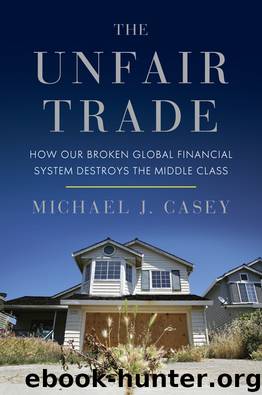The Unfair Trade by Michael J. Casey

Author:Michael J. Casey [Casey, Michael J.]
Language: eng
Format: epub
ISBN: 978-0-307-88532-6
Publisher: Crown Publishing Group
Published: 2012-05-28T16:00:00+00:00
The Circular Relationship
“I feel like a weatherman in California. Every day is sunny,” said U.S. government bond strategist William O’Donnell when I visited RBS’s Stamford trading floor on November 9, 2010, the day of the monthly auction for the Treasury’s new ten-year notes, its benchmark issue. The Fed had begun its second round of “quantitative easing” bond purchases, and Brazilian finance minister Guido Mantega had just uttered his headline-grabbing “global currency war” remark. The global conditions reflected in these developments ensured that the U.S. government’s $24 billion debt offering would do swimmingly well. The bid-to-cover ratio, which compares the dollar tally of orders received with the amount of debt the Treasury puts on offer, came in at a very healthy 2.80. And indirect bids—considered a proxy for foreign central banks—hit their highest level since records of that kind began being kept in 2003. O’Donnell, whose desk sported a postcard with a stylized picture of Ronald Reagan pointing outward in the manner of Uncle Sam and saying “I Need YOU to Stop Socialism,” showed me on his Bloomberg terminal how traders from the primary dealers had done a “masterful job” in wooing investors into the market. They’d sold a small amount of the ten-year bonds just before the auction so that the yield—the interest return for investors at a given value, a number that always moves inversely to the bond price—would rise to enticing levels. Then, when the 1:00 p.m. auction came, the buying took off. It seemed like everybody had won.
Members of the RBS team were in a jocular mood after the auction. Their work area was arranged according to what Michael Lyublinsky, co-head of Global Bank and Markets for the Americas, described as an “egalitarian” model, where traders of differing rank, salesmen, analysts, and economists were intermingled and each assigned about four square feet of free desk space and three computer screens. They were mainly men of between twenty-five and forty-five, most dressed in open-neck or polo shirts coupled with khakis or other casual pants, with a sprinkling of women. A few traders tossed quarters back and forth, settling friendly wagers. There was a distinctly upbeat feel to the place.
O’Donnell explained how the Fed’s second round of quantitative easing, or “QE2,” had worked its wonders on the market. News of the seven-month, $600 billion program to buy Treasury bonds, a follow-up to a $1.75 billion initiative carried out in the year following the crisis, had not only supported the U.S. government bond market but driven down the value of the dollar. That’s because quantitative easing, so called because the Fed’s asset purchases increase the quantity of money in the economy, expands the supply of dollars relative to that of other currencies. But foreign central banks weren’t happy with this trend, which undermined their exporters’ competitiveness and generated large inflows of dangerously volatile “hot money” into their financial systems. So they moved to prevent their currencies from rising by buying greenbacks in their own markets, which they then recycled back into Treasuries.
Download
This site does not store any files on its server. We only index and link to content provided by other sites. Please contact the content providers to delete copyright contents if any and email us, we'll remove relevant links or contents immediately.
International Integration of the Brazilian Economy by Elias C. Grivoyannis(90750)
The Radium Girls by Kate Moore(11921)
Turbulence by E. J. Noyes(7935)
Nudge - Improving Decisions about Health, Wealth, and Happiness by Thaler Sunstein(7615)
The Black Swan by Nassim Nicholas Taleb(7010)
Rich Dad Poor Dad by Robert T. Kiyosaki(6399)
Pioneering Portfolio Management by David F. Swensen(6226)
Man-made Catastrophes and Risk Information Concealment by Dmitry Chernov & Didier Sornette(5921)
Zero to One by Peter Thiel(5684)
Secrecy World by Jake Bernstein(4643)
Millionaire: The Philanderer, Gambler, and Duelist Who Invented Modern Finance by Janet Gleeson(4374)
The Age of Surveillance Capitalism by Shoshana Zuboff(4209)
Skin in the Game by Nassim Nicholas Taleb(4161)
Bullshit Jobs by David Graeber(4094)
The Money Culture by Michael Lewis(4075)
Skin in the Game: Hidden Asymmetries in Daily Life by Nassim Nicholas Taleb(3929)
The Dhandho Investor by Mohnish Pabrai(3698)
The Wisdom of Finance by Mihir Desai(3650)
Blockchain Basics by Daniel Drescher(3497)
